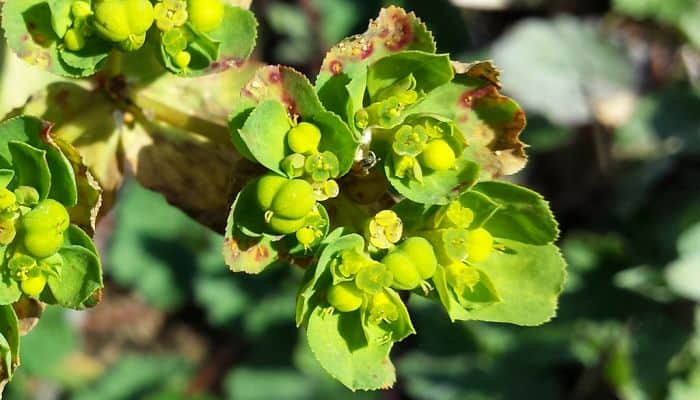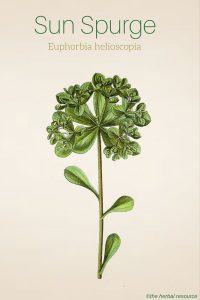Botanical Name: Euphorbia helioscopia.
The genus Euphorbia (spurge) contains over 1600 species making it one of the most species-rich plant genus in the world.
The common characteristic of all these species is that they contain poisonous, milky latex-like sap that tastes strong and bitter.
Since it is the sap that has been used medicinally, these species are interchangeable.
Other Common Names: Wart spurge, umbrella milkweed, wartweed, madwoman’s milk, euforbia girasol (Spanish), åkervortemelk (Norwegian), Sonnenwend-Wolfsmilch (German), euphorbe réveille-matin (French), revmorstörel (Swedish), skærm-vortemælk (Danish).
Habitat: Sun Spurge is native to Europe, Central Asia, and North Africa, and it has been introduced by humans and naturalized in other parts of the world, so now it is close to having cosmopolitan distribution.
The plant is considered to be a weed and grows best in open areas and nutritious soil. It can often be found in fields, gardens, parks, mounds and fallow land.
Description: Sun spurge is an annual belonging to the spurge family (Euphorbiaceae). It can grow up to 10-30 cm in height with base branched and sparsely hairy stems.
The yellow-green leaves are oval, broadest above the middle and finely toothed on the upper half.
The tiny flowers have two to five basal bracts. They are similar to the leaves but more yellow-green. The plant blooms from mid-spring to late summer.
The seed capsule is 3-4 mm, smooth and glabrous, the seeds are dark brown with wrinkles.
Plant Parts Used: The white sap latex is the only part of the plant that has been used as herbal medicine.
It should only be used externally but in the past, the dried plant sap was also used internally, but such use is now strongly discouraged due to the herb’s toxicity.
Traditional Uses, Therapeutic Benefits and Claims of Sun Spurge
Active Ingredients and Substances: Sun spurge and other species belonging the genus Euphorbia contain a white latex-like sap with several active ingredients, including the poisonous substance euphorbon and some very strong irritants.
The toxic sap is found in all parts of the plant, and the toxic effect is not diminished by drying.
A Remedy for Warts
Throughout the ages, the milky sap latex of plants belonging to the spurge family has been regarded as an effective remedy against warts (including verrucas).
It has also been used to treat corns and ringworms.
If the sap latex is used as a natural treatment for warts it must be applied with care so it does not come into contact with the surrounding skin.
Other Applications of Sun Spurge
The dried plant sap of sun spurge (and other euphorbia species) was once used internally as laxative and emetic but due to the toxicity of the herb, it probably did more harm than good, even causing fatalities.
In the past women rubbed the sap on their cheeks which irritated the skin and increased blood flow resulting in a rosy fresh look. But this practice could also lead to blistering and sores that took a long time to heal.
From the Isle of Man comes one of the strangest use of the plant as an aphrodisiac or “natural viagra” of sorts. Small amounts of the milky sap were rubbed on the penis glans to make it swell.
This practice to increase sexual arousal was well known among the locals and the plant was often referred to as “Saturday-night-pepper”. This method is far from being safe and should not be tried as it may cause serious injury!
Dosage and Administration
Because of the plant’s toxicity, it should not be included in any homemade herbal preparations or remedies. It should only be used externally in very small quantities as a treatment for warts.
To be on the safe side it is highly recommended to contact a skilled herbalist regarding the use of the herb prior to use.
Possible Side Effects and Interactions of Sun Spurge
Sun Spurge and all species belonging to the Genus Euphorbia are poisonous and must be treated with caution.
The sap can cause severe inflammation and blistering if it comes in direct contact with the skin.
If the sap comes in contact with the eyes it can cause serious damage to the cornea and at worst blindness. If exposed, the eyes should be rinsed immediately with water followed by a visit to the nearest hospital emergency room.
If the herb is ingested it can lead to a sharp local irritation of the mucous membranes in the mouth and throat, dizziness, acute gastrointestinal disorders with vomiting, diarrhea, cramping, and severe pain.
When the plant’s toxins are absorbed they begin to cause grogginess, affect the circulatory system, inducing cold sweats and dilating the pupils.
Children are especially susceptible to the herb’s toxic effect. Treatments for internal Euphorbia poisoning include; inducing vomiting, drinking lots of water and charcoal.
Supporting References
Allen, David E. & Gabrielle Hatfield: Medicinal Plants in Folk Tradition. An Ethnobotany of Britain & Ireland. Portland / Cambridge, Timber Press 2004.
Barker, Julian: The Medicinal Flora of Britain & Northwestern Europe. Kent, Winter Press 2001.
Turner, Nancy J. and Adam F. Szczawinski: Common Poisonous Plants and Mushrooms of North America. Portland, Timber Press 1997.
Wink, Michael & Ben-Erik van Wyk: Mind-Altering and Poisonous Plants of the World. Portland, Oregon, Timber Press 2008.
Thordur Sturluson
Latest posts by Thordur Sturluson (see all)
- What is the Difference Between Hemp and Marijuana? - June 3, 2019

